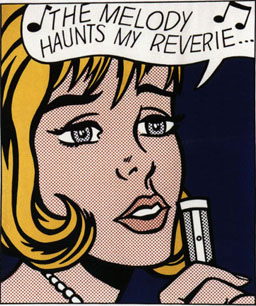
Roy Fox Lichtenstein was an American pop artist. During the 1960s, along with Andy Warhol, Jasper Johns, and James Rosenquist, he became a leading figure in the new art movement. His work defined the premise of pop art through parody. Inspired by the comic strip, Lichtenstein produced precise compositions that documented while they parodied, often in a tongue-in-cheek manner. His work was influenced by popular advertising and the comic book style. His artwork was considered to be "disruptive". He described pop art as "not 'American' painting but actually industrial painting". His paintings were exhibited at the Leo Castelli Gallery in New York City.

Edward Joseph Ruscha IV is an American artist associated with the pop art movement. He has worked in the media of painting, printmaking, drawing, photography, and film. He is also noted for creating several artist's books. Ruscha lives and works in Culver City, California.

Russell Heath Jr., was an American artist best known for his comic book work, particularly his DC Comics war stories and his 1960s art for Playboy magazine's "Little Annie Fanny" feature. He also produced commercial art, two pieces of which, depicting Roman and Revolutionary War battle scenes for toy soldier sets, became familiar pieces of Americana after gracing the back covers of countless comic books from the early 1960s to early 1970s.

Whaam! is a 1963 diptych painting by the American artist Roy Lichtenstein. It is one of the best-known works of pop art, and among Lichtenstein's most important paintings. Whaam! was first exhibited at the Leo Castelli Gallery in New York City in 1963, and purchased by the Tate Gallery, London, in 1966. It has been on permanent display at Tate Modern since 2006.

Girl with Ball is a 1961 painting by Roy Lichtenstein. It is an oil on canvas Pop art work that is now in the collection of the Museum of Modern Art, after being owned for several decades by Philip Johnson. It is one of Lichtenstein's earliest Pop art works and is known for its source, which is a newspaper ad that ran for several decades and which was among Lichtenstein's earliest works sourced from pop culture.

Look Mickey is a 1961 oil on canvas painting by Roy Lichtenstein. Widely regarded as the bridge between his abstract expressionism and pop art works, it is notable for its ironic humor and aesthetic value as well as being the first example of the artist's employment of Ben-Day dots, speech balloons and comic imagery as a source for a painting. The painting was bequeathed to the Washington, D.C., National Gallery of Art upon Lichtenstein's death.
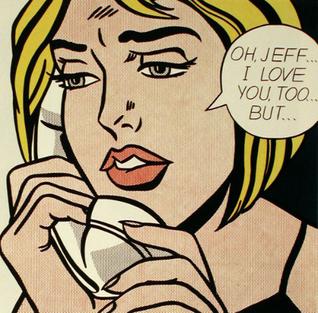
Oh, Jeff...I Love You, Too...But... is a 1964 oil and magna on canvas painting by Roy Lichtenstein. Like many of Lichtenstein's works its title comes from the speech balloon in the painting.
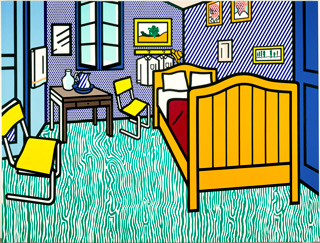
Bedroom at Arles is a 1992 oil and Magna on canvas painting by Roy Lichtenstein based on the Bedroom in Arles series of paintings by Vincent van Gogh. He painted it in July 1992. It is the only quotation of another painting that Lichtenstein did of an interior. It is located on the Fitzhugh Farm in Maryland in the Robert and Jane Meyerhoff Collection.
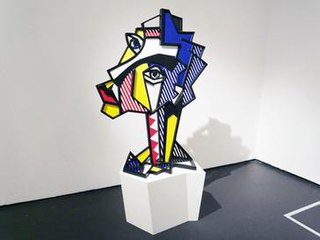
Expressionist Head by pop artist Roy Lichtenstein is the name associated with several 1980s works of art. It is widely associated with a set of six identical sculptures but is also associated with a series of paintings.

Big Painting No. 6 is a 1965 oil and Magna on canvas painting by Roy Lichtenstein. Measuring 235 cm × 330 cm, it is part of the Brushstrokes series of artworks that includes several paintings and sculptures whose subject is the actions made with a house-painter's brush. It set a record auction price for a painting by a living American artist when it sold for $75,000 in 1970. The painting is in the Kunstsammlung Nordrhein-Westfalen collection.
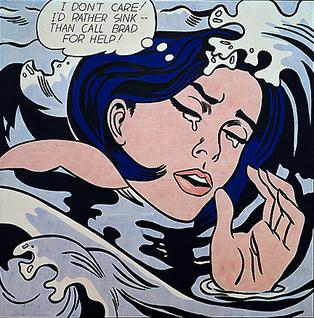
Drowning Girl is a 1963 American painting in oil and synthetic polymer paint on canvas by Roy Lichtenstein, based on original art by Tony Abruzzo. The painting is considered among Lichtenstein's most significant works, perhaps on a par with his acclaimed 1963 diptych Whaam!. One of the most representative paintings of the pop art movement, Drowning Girl was acquired by the Museum of Modern Art in 1971.
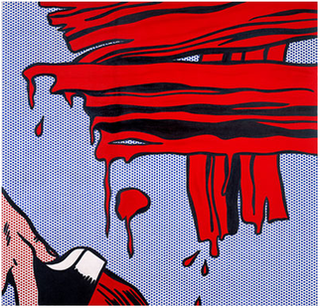
Brushstrokes series is the name for a series of paintings produced in 1965-1966 by Roy Lichtenstein. It also refers to derivative sculptural representations of these paintings that were first made in the 1980s. In the series, the theme is art as a subject, but rather than reproduce masterpieces as he had starting in 1962, Lichtenstein depicted the gestural expressions of the painting brushstroke itself. The works in this series are linked to those produced by artists who use the gestural painting style of abstract expressionism made famous by Jackson Pollock, but differ from them due to their mechanically produced appearance. The series is considered a satire or parody of gestural painting by both Lichtenstein and his critics. After 1966, Lichtenstein incorporated this series into later motifs and themes of his work.

Brushstrokes is a 1965 oil and Magna on canvas pop art painting by Roy Lichtenstein. It is the first element of the Brushstrokes series of artworks that includes several paintings and sculptures. As with all of his Brushstrokes works, it is in part a satirical response to the gestural painting of Abstract Expressionism.

Woman with Flowered Hat is a 1963 pop art painting with Magna on canvas by Roy Lichtenstein. The work is based on a Pablo Picasso portrait of Dora Maar. In May 2013, it sold for a record price for a Lichtenstein work.

Crying Girl is the name of two different works by Roy Lichtenstein: a 1963 offset lithograph on lightweight, off-white wove paper and a 1964 porcelain enamel on steel.

Hopeless is a 1963 painting with oil paint and acrylic paint on canvas by Roy Lichtenstein. The painting is in the collection of the Kunstmuseum Basel.
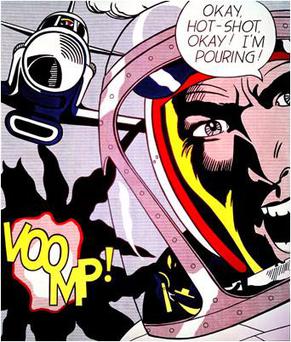
Okay Hot-Shot, Okay! is a 1963 pop art painting by Roy Lichtenstein that uses his Ben-Day dots style and a text balloon. It is one of several examples of military art that Lichtenstein created between 1962 and 1964, including several with aeronautical themes like this one. It was inspired by panels from four different comic books that provide the sources for the plane, the pilot, the text balloon and the graphic onomatopoeia, "VOOMP!".

Jet Pilot is a 1962 pop art work done in graphite pencil by Roy Lichtenstein. Like many of Lichtenstein's works from this time period, it was inspired by a comic book image, but he made notable modifications of the source in his work.

Varoom! is a 1963 pop art painting by Roy Lichtenstein that depicts an explosion and the onomatopoeic sound that gives it its name.

Ten Dollar Bill is a 1956 proto-pop art lithographic drawing by Roy Lichtenstein. Considered to be a combination of Americana art and cubism, the work is referred to as the beginning of Lichtenstein's work on pop art. Twenty-five editions of the lithograph were made by Lichtenstein, which were exhibited at several galleries. The piece is based on the design for the ten-dollar bill and has influenced several of Lichtenstein's later works. The picture has received generally favorable reception from critics, and is considered to be one of the best artistic portrayals of currency.
